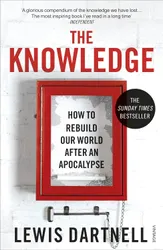This book styles itself as a manual for rebuilding our technological civilization after some kind of catastrophic event that wipes out most of our present civilization. Several possibilities are considered as causes of the catastrophe. The author’s ‘preferred’ seems to be a global pandemic that wipes out most of the population (the book was written in 2014, before the COVID-19 pandemic) because it would leave most of the infrastructure and equipment in place. This would make it easier to scavenge equipment and materials from the remains, giving the survivors a head start in rebuilding. But of course we don’t get to choose the method by which our civilization ends, and global nuclear war or an asteroid strike could leave much of our technology unusable.
It turns out that a lot of what makes the modern world possible is essentially chemistry. This includes the ability to smelt metals to make lots of usable objects, as well as other processes to create useful chemicals for fuel, cleaning, energy storage and fertilising crops.
Although this book considers science to be important, and does a good job of explaining the scientific method to the survivors, it really takes the approach that it’s primarily technology and practical knowledge that will allow us to rebuild the most effectively. As a result, there isn’t all that much science in this book. It leaves out a lot of the detail of what we’ve already figured out where this isn’t needed for technological development. The book contains a lot of recipes for making various chemicals, for example, but it stops short of giving chemical formulae, or going into much detail about the structure of the atom, its shells of electrons, and how this results in all the chemistry that we make use of in our modern world. The book mentions the periodic table, and how important it is, without actually including a copy. I would make the case that including the periodic table, and some information about nuclei and electron shells, might shave several decades off our redevelopment time!
The technology described in the book doesn’t get us all the way to modernity. We might get electricity, light bulbs, internal combustion engines, and the Haber-Bosch process for extracting nitrogen (for fertilisers) from the atmosphere. With these technologies, civilization might get to a point equivalent to the early 20th century. But we would be on our own to develop semiconductors, nuclear physics and reactors, and fundamental physics like relativity and quantum mechanics.
The book doesn’t touch upon the politics of rebuilding or what sort of political structures might emerge or be the most effective to help with the rebuilding process. Presumably this would be too dependent on how many people survived and where they were located. But it does talk about the importance of efficient agriculture in order to free people up from scavenging and hunting so that they could further develop useful technologies. As well the chemical processes to create fertilizers, useful tools and machinery are described to help with ploughing, sowing seeds, the milling of grain and other agriculture-related tasks.
This book is a really interesting thought experiment in how civilization might rebuild itself after a catastrophe. It made me realise how difficult and perhaps unlikely this rebuilding process would be. I think it would genuinely be a useful book to have around in the event of an apocalypse. It also gave me insight into how complex and interdependent our current technological society really is, and I learned a lot about how the modern world works from reading it.
